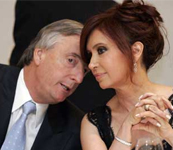“Nestor isn’t going.” “Cristina Power.” “Thanks, Nestor.” These are some of the phrases voiced by the thousands of Argentines who passed by the Casa Rosada (“Pink House”), Argentina’s presidential residence, to pay their respects to ex-president Nestor Kirchner, who governed the country from 2003 to 2007. A sudden heart attack ended the life of the 60-year old politician, who died in the arms of his wife, President Cristina Fernández de Kirchner, while they were resting in their house in El Calafate, a city in Patagonia, in Argentina’s far south.
At 9:15 a.m. on Wednesday, October 27, the political history of Argentina changed forever. Observers agree that Kirchner was the main source of political support for current president Cristina Fernández de Kirchner, his wife. Ever since 2007, when Nestor Kirchner transferred control of the country to his Cristina, who had broad experience as a legislator, the “K Couple” dominated the country’s political scene. Now, all eyes will be on Cristina. How will her administration function without her husband’s influence? Will she be able to deal with the challenges of governing the country until the next presidential elections in 2011?



